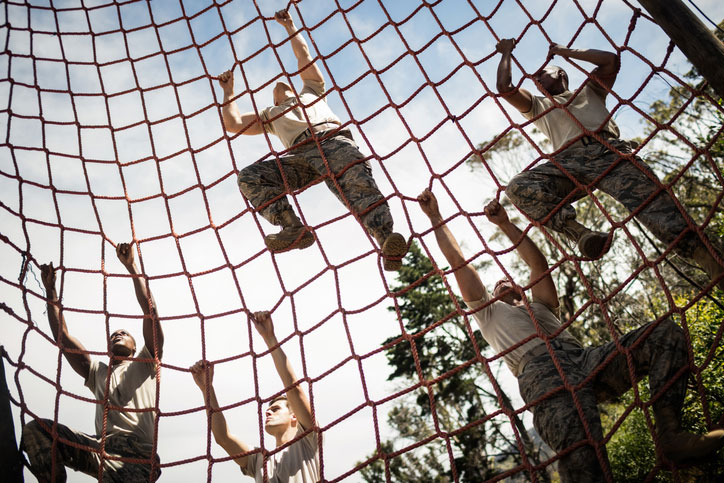
The appearance of U.S. Department of Defense (DoD) visual information does not imply or constitute DoD endorsement.
Most people who take on the challenge of becoming commissioned officers do so to proudly dedicate themselves to long-term military careers. Officer Candidate School (or Officer Training School, for Air Force and Space Force) marks the first step to that career after completing college.
OCS/OTS is the training that sets officers apart from enlisted personnel in every service. It offers a more intellectually challenging path to service, and one that also holds greater rewards. Officers get paid more, perform more interesting and challenging jobs, and have more career options in and out of the service.
OCS is only open to individuals who have already earned at least a bachelor’s degree.
If you haven’t yet earned that four-year degree, you’ll want to take a look at our Pre-Service College Guide to learn how you might be able to take advantage of DoD education benefits and other options even before you begin your military service.
Becoming a commissioned officer also opens up many other kinds of training, both through formal college courses and also in elite military schools of every stripe. You will even find options to get the military to pay for a graduate degree if you play your cards right (and sign up for a few more years of service).
But first you need get through a rigorous set of training that will push you both physically and mentally. You’ll be glad you have that college degree already—those study skills will serve you well as you are cramming for courses on damage control procedures or learning the intricacies of celestial navigation.
Explore Your Military Training and Degree Options
What Is Officer Candidate School Like Today?
At one time, most OCS programs were specific to different departments or branches within each service. Over time, though, each service has moved toward offering a more general leadership and skills training school. You’ll get your MOS-specific training on the job, or at other service schools.
That means OCS/OTS programs now revolve heavily around leadership training, organizational development, and the military essentials of the service. For ground branches, that means land navigation, strategy, and tactics; in Air and Space Force, training around air power and the precepts of aerial warfare; and in the Navy and Coast Guard, an understanding of nautical tradition, naval warfare, and logistics.
Officer Training for the National Guard Works a Bit Differently
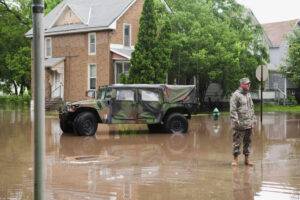 Although each branch offers a dedicated officer training program for active duty officers, the process of going through OCS for officers joining the National Guard may be a bit different.
Although each branch offers a dedicated officer training program for active duty officers, the process of going through OCS for officers joining the National Guard may be a bit different.
Because Guard service is not full time, neither are their officer candidate schools. Spending three months at a dedicated officer training program isn’t in the cards for anyone who has to hold down a regular job on top of their service.
So state Guard establishments run their own OCS programs, with a more relaxed timeline. Typically, these mirror regular Guard service: one weekend per month and two two-week blocks, spread out over 16 to 18 months.
An accelerated option may be available in some states, which crams everything into a single eight-week straight session, with courses seven days per week.
The Air National Guard is slightly different in that all officer training is centralized through the Air Force. A separate six-week program called the Academy of Military Science was used for future Guard officers. In 2009, it was integrated into mainstream Air Force OTS, and now all ANG officers are expected to progress through the normal nine-and-a-half-week Air Force OTS.
Each of these schools are challenging in their own way. Each of them unlocks a career path that demands more and offers higher responsibility as you go. And you wouldn’t want it any other way.
Army Officer Candidate School – Fort Benning, Georgia
Getting into Officer Candidate School - Army
U.S. Army officer candidate school accepts about 65 percent of applicants.
Army OCS is open to enlisted personnel through certain enlisted-to-officer programs, warrant officers, or civilians who have enlisted through the OCS option after completing Basic Combat Training. You must also:
- Be between 19 and 32 years of age
- Be eligible for a security clearance
- Hold a four-year college degree
- Have less than six years of active federal service
Army Officer Candidate School Scheduled Length: 12 weeks
Army OCS is the shortest path to commissioning for regular officers by a long shot. But it also requires the most individual grit and motivation. Instructors are always available to provide information and correct issues. They are also going to constantly be testing your mettle through hard physical activities and even harder tests and field problems.
You will spend plenty of time in the classroom at OCS, but your coursework won’t be like any college class you’ve ever taken. Instead, you’re thrown into the gritty details of calling in fire missions, delivering a 9-line MEDEVAC request under pressure, and writing up platoon orders on short notice.
Because you hit OCS only after completing BCT, most of the crawling through mud and formal drills are behind you. But you will absolutely get smoked on the regular; standards are high for future leaders. And field exercises will force you to put those basic military skills through their paces—all while leading a squad and solving problems under pressure.
There are only two phases to Army OCS:
- Basics of Officership - The first six weeks of OCS take you through physical fitness testing, leadership principles, and various exercises like the Leadership Reaction Course to assess and improve on your skills as a leader, and the Combat Water Survival Test. You’ll also go through classroom instruction in areas such as:
- Military intelligence
- Battle Drills
- Map Reading and Navigation
- Military History
- Applied Field Exercises - The second half of Army OCS puts you in the field to further develop and practice your skills. You’ll rotate through leadership positions with your fellow cadets in exercises that offer each of you the opportunity to step up and show your stuff.
As you rotate through leadership positions in the cadet class, you’ll find that the training cadre are interested in giving you the instruction you need to succeed. Graduation rates range between 80 percent and 90 percent, so your odds of completing the program are good as long as you stay switched on and motivated.
Air and Space Force Officer Training School – Maxwell Air Force Base, Alabama
Getting into Officer Training School - Air Force
Air Force and Space Force OTS is open to civilians and selected enlisted personnel through commissioning programs who meet these requirements:
- Be between 18 and 39 years of age
- Be a U.S. citizen
- Hold at least a bachelor’s degree
- Pass the Air Force Officer Qualifying Test
Almost half of OTS slots go to candidates from various Air Force enlisted-to-officer commissioning programs.
Air Force OTS acceptance rates vary widely from year to year, ranging from below 10 percent to over 60 percent.
The Air Force also uses a set of selection boards to evaluate officer candidates. Air Force officer positions are either rated, which means flight duty, or non-rated, for all other commissioned positions. Different selection boards are used for each type of commission. They weigh factors such as:
- Academic discipline and grade point
- Work experience
- Extracurricular accomplishments
- Character and leadership ability
You’ll need to be selected by the relevant board to be admitted to OTS.
Since most active duty Air Force officers come in through the Academy or AFROTC, OTS is used as a program to fill in the gaps. That makes the demand, and acceptance rates, far less predictable than other services.
How Long is Officer Training School – Air Force: 9.5 weeks
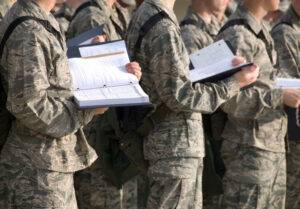 OTS is a relatively small school. In 2021, only 273 candidates were selected. But it’s a much faster entry point to commissioning if you can qualify.
OTS is a relatively small school. In 2021, only 273 candidates were selected. But it’s a much faster entry point to commissioning if you can qualify.
Air Force officer training may be the most technically-oriented of any service. Although you will learn drill and spend your share of time marching in formation, most candidates identify the classroom coursework as the most challenging part of the program. The Consolidated Written Test is the nemesis of many officer candidates who breeze through the PT and tactical parts of the program.
OTS is split into four phases:
- Indoctrination - Concentrates on teamwork, discipline, and basic military skills
- Development - Teaches the history of the Air Force and fundamentals of leadership, military management, and the profession of arms. Basic combat skills are introduced.
- Application - Practical exercises testing your new skills together with rotations through leadership positions for other new OTS candidates will cement your training and prepare you for evaluation.
- Transition - Mentoring and individual preparation for duties offer a practical transition into your new duties as an Air Force officer
In addition to classroom time, candidates are put through high-pressure, team-based problem solving scenarios. You will also spend time in the field, practicing tactical issues for base defense and security, accident response, and developing basic military skills.
Uniquely, Air Force OTS includes a computerized war-game scenario, simulating a large scale air campaign.
Follow-on training in your selected specialization is usually your next assignment after completing OTS. These programs are often even longer and more intensive, dealing with flight training, navigation, or other highly technical programs.
Navy Officer Candidate School – Naval Station Newport, Rhode Island
Getting into Officer Candidate School - Navy
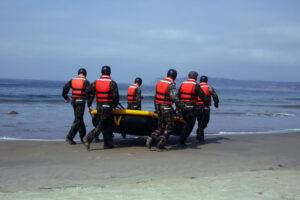 The Navy is unique in that it has different age and educational requirements for OCS admission based on the officer rating program you are being admitted under. For example, a Nuclear Propulsion Officer Candidate has to be between 18 and 29 years of age and have a college degree with certain physics and science courses taken. A Public Affairs Officer candidate can be between 29 and 42, however, with a degree in any field.
The Navy is unique in that it has different age and educational requirements for OCS admission based on the officer rating program you are being admitted under. For example, a Nuclear Propulsion Officer Candidate has to be between 18 and 29 years of age and have a college degree with certain physics and science courses taken. A Public Affairs Officer candidate can be between 29 and 42, however, with a degree in any field.
Each Navy Officer Candidate Program has a selection board and each selection board can have different acceptance rates each year.
Both civilians and current enlisted sailors are eligible to apply to OCS.
How Long is Navy Officer Candidate School: 13 weeks
The Navy turns you over to the tender ministrations of the United States Marine Corps, in addition to Navy cadre, for the duration of Naval OCS. You can expect a surprising amount of yelling and physical discipline, beginning at 0400 on day one.
Navy OCS is split into four main phases:
- Indoctrination (INDOC) - Indoctrination is an intense three-week phase where you go through in-processing, paperwork, medical clearances, and basic drill instruction. Room inspections and physical training dominate this phase.
- Junior Officer Candidate (JOC) / Senior Officer Candidate (SOC) - Although these are technically separate phases, other than additional chow time and a different uniform to wear, differences are minimal. This period will see you in classrooms for more than seven hours each day, absorbing and being tested on a firehose of naval information.
- Candidate Officer (Candio) - Candios take on some of the responsibilities for training earlier phase candidates. This offers leadership training through practical experience, giving you the opportunity to take charge of the training regiment itself under the watchful eyes of cadre instructors. You’ll be teaching JOC and SOC classes, so you better have absorbed all that information.
At one point, the Navy offered a separate OCS program for future Naval aviators called AOCS, or Aviation Officer Candidate School. Today, all prospective Naval aviators go through standard Navy OCS prior to flight training in Pensacola.
The modern Navy has a lot of territory to cover in terms of responsibilities and technologies. Your academic coursework may be the most challenging part of Navy OCS, and covers:
- Division Officer Fundamentals
- Naval History
- Engineering & Weapons
- Damage Control
- Leadership and Ethics
- Navigation
- Cyber
Naturally, however, when Marine Corps sergeants have the opportunity to get their hands on prospective Naval officers, you can also expect plenty of fundamental military and physical training, too. Expect room, locker, and personnel inspections that drill down into the most minute specks of dirt, fibers of clothing out of place, or creases in bedding. And you’ll go through the legendary Marine Corps manual of arms rifle drill.
Navy OCS culminates in Battle Stations, held aboard the USS Trayer… the unluckiest ship in the Navy. The Trayer is a permanently dry-docked replica of an actual Arleigh Burke class destroyer. Candios are put through a complete simulation of provisioning, getting under way, and manning general quarters on board. Only there are no false alarms on Trayer; during the 12 hours of Battle Stations, candidates will face fire, flooding, and both mechanical and personnel casualties that they must overcome to graduate.
Marine Officer Candidate School – Marine Corps Base Quantico, Virginia
Getting into Marine Corps Officer Candidate School
The acceptance rates for Marine Corps OCS tend to run around 70 percent. Graduating is another story.
The Marines have high standards for officers, but admissions to OCS only require you to meet these basic requirements:
- Be between the ages of 20 and 28
- Pass a criminal background check
- Pass the Initial Strength Test
- Hold both a college degree and a high school diploma
- Pass the ASVAB with a score of 31 or higher
USMC Officer Candidate School Length: 10 weeks
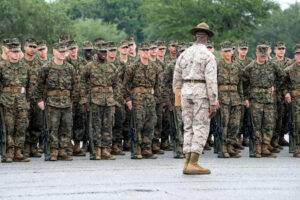 Marine OCS is unique in that both NROTC (Naval Reserve Officers’ Training Corps) and direct OCS entrants pass through the same school at Quantico. Even Marine officers coming from Annapolis are required to undergo a four-week training experience here.
Marine OCS is unique in that both NROTC (Naval Reserve Officers’ Training Corps) and direct OCS entrants pass through the same school at Quantico. Even Marine officers coming from Annapolis are required to undergo a four-week training experience here.
This gives Marine officers a common experience and enormous esprit d’corps.
And they need all the esprit d’corps they can get, because they are going on to lead enlisted personnel who have come through one of the toughest basic military training courses in the world.
Marine OCS is even harder than Marine Corps bootcamp. OCS offers the same basic military training skills as bootcamp, but integrates leadership instruction and testing with the program. On top of the extreme physical demands, your mental endurance and performance will be taken to the limit as the drill instructors evaluate you for performance under stress. The whole idea is to put your learning experience in the pressure cooker and see if you can cope.
There are five phases in Marine OCS:
- In-processing - Your basic qualifications and medical and physical screening are conducted. Gear will be assigned and the first of many, many reams of paperwork that you will fill out during your career as a Marine officer will be completed.
- Transition - Basic military procedures are taught, at high volume, including formation, drill, combat conditioning, cultural adaptation, and leadership indoctrination.
- Adaptation - During this phase, officer candidates are assigned to lead their peers in turn through exercises and evaluations. Candidates are expected to lead squads and take responsibility for both individual and collective performance, identifying issues and problem-solving for success.
- Decision Making and Execution - This is the culminating phase of Marine Corps OCS, with tactical instruction and leadership qualities assessed in a series of field problems. You’ll develop tactical decision making skills and be evaluated for your performance dealing with tough leadership decisions in the field.
- Out-Processing - With the toughest parts of OCS behind you, drill sergeants will start to prepare you for your next assignment at The Basic School and to continue your orientation toward future leadership roles in the Corps.
The Quigley is a legendary, water-filled, snake-infested, barbed-wire festooned 50-yard section of the OCS Combat Course that has been the nemesis of Marine officer candidates since 1967.
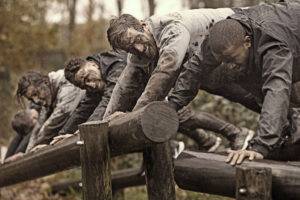 Moreso than the other services, Marine OCS is designed to weed out anyone not up to standard. That means the focus is less on learning and more on evaluation. Also, unlike other services, all Marine officers, other than Direct Entry, attend a second program, The Basic School, to teach them the tactical trade. That means the qualities you are expected to exhibit in OCS have more to do with character and leadership potential than tactics and strategy.
Moreso than the other services, Marine OCS is designed to weed out anyone not up to standard. That means the focus is less on learning and more on evaluation. Also, unlike other services, all Marine officers, other than Direct Entry, attend a second program, The Basic School, to teach them the tactical trade. That means the qualities you are expected to exhibit in OCS have more to do with character and leadership potential than tactics and strategy.
Around a quarter of all officer candidates fail out of Marine OCS, which tells you a lot about how tough it is. But on the plus side, you’ll never find a civilian job that will make you lose your cool after surviving Marine OCS.
United States Coast Guard Officer Candidate School – Coast Guard Academy, New London, Connecticut
Getting into USCG Officer Candidate School
Some people are surprised to find that the Coast Guard is the toughest OCS program to get into. Only around 15 percent of applicants make it. You have a better shot at being accepted to the highly competitive Coast Guard Academy!
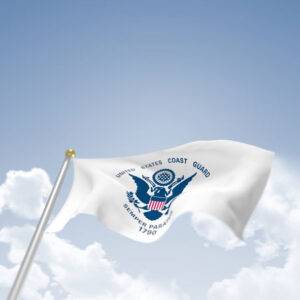 The Coast Guard is the smallest service and the most selective when it comes to recruiting officers.
The Coast Guard is the smallest service and the most selective when it comes to recruiting officers.
The Coast Guard is known for pushing considerable responsibility down into non-commissioned ranks, so applicants from the service will almost always have an edge. While both civilian and current enlisted Coast Guard members may apply to OCS, most classes are filled by prior service enlisted.
There are two entry paths to USCG OCS:
- OCS-R - Open to both civilian and current enlisted, civilians are placed in reserve status on active duty during the initial four-year contract, and promoted to officer during that time or otherwise discharged.
- OCS-T - Open only to current enlisted Coast Guard personnel, this is similar to OCS-R in that graduates are rated as temporary officers upon graduating.
In either case, you must be:
- At least 21 years of age but no older than 35
- Be a U.S. Citizen
- Be eligible for secret clearance
- Have no more than 3 dependents
- Hold a bachelor’s degree or higher with a minimum 2.5 GPA
- Meet certain financial standards
- Achieve a ASVAB score of 109 or Combined SAT of 1100 or higher
Additionally, the Coast Guard uses a selection board system to evaluate candidates. This means you can expect to have to impress during board interviews and with demonstrated commitment, aptitude, and related experience.
Coast Guard Officer Candidate School Length: 17 weeks
There are only two USCG OCS classes each year, due to the length and small pool of cadets.
The Coast Guard offers the longest and most thorough of all American military OCS programs. Moreover, it’s co-located with the Coast Guard Academy, which means you’ll be training alongside cadets and under many of the same instructors.
Coast Guard training has to cover the full range of demands on the most flexible service. Since the Coast Guard straddles the civilian and military worlds, you will spend as much time preparing to deal with natural disasters as with law enforcement or port protection tactics. The coursework will include:
- Incident Command System
- Nautical Rules of the Road
- Search and Rescue
- Shipboard Organization
- Financial Management
- Ship Handling
- Damage Control
But like other OCS programs, you will start off Coast Guard OCS with drill, watch standing, and the essentials of military etiquette and protocol. Plenty of physical conditioning will happen along the way.
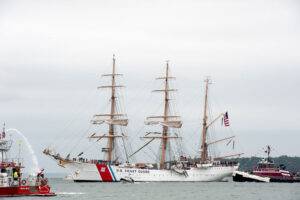 Leadership and management are stressed throughout the length of the program, determining your skills and suitability for the position of Coast Guard officer.
Leadership and management are stressed throughout the length of the program, determining your skills and suitability for the position of Coast Guard officer.
Officer candidates in the Coast Guard also have the unique opportunity to undergo a long cruise on the USCGC Eagle, a nearly 300-foot long barque where sailors are made the old-fashioned way… heaving on halyards, scrambling up ratlines, and navigating by the stars.
While Coast Guard OCS is thorough and in-depth, it’s best to think of it as part of a longer apprenticeship process. That’s because all OCS candidates are effectively on probation for the first four years of their term. OCS-R entrants are classified as reservists but placed on active duty for four years. If they are promoted in that time, they may remain in active duty status; otherwise, they are discharged.
For OCS-T candidates, they are considered temporary officers for their first four years. At the end of that period, if they have not been promoted, then they will revert back to their enlisted rank.
So Coast Guard OCS is just the beginning of a longer period of evaluation for your suitability as an officer. It’s hard to get in and hard to stay in—but those who make the grade can be counted on to keep America’s shores safe.





